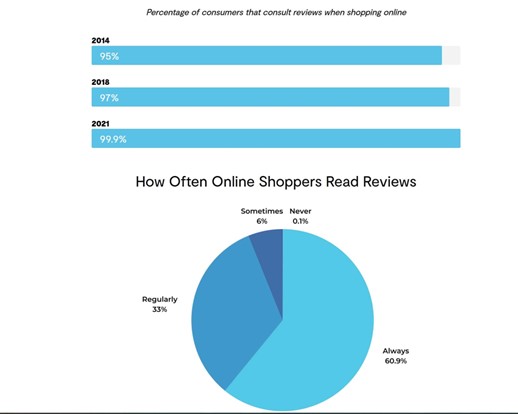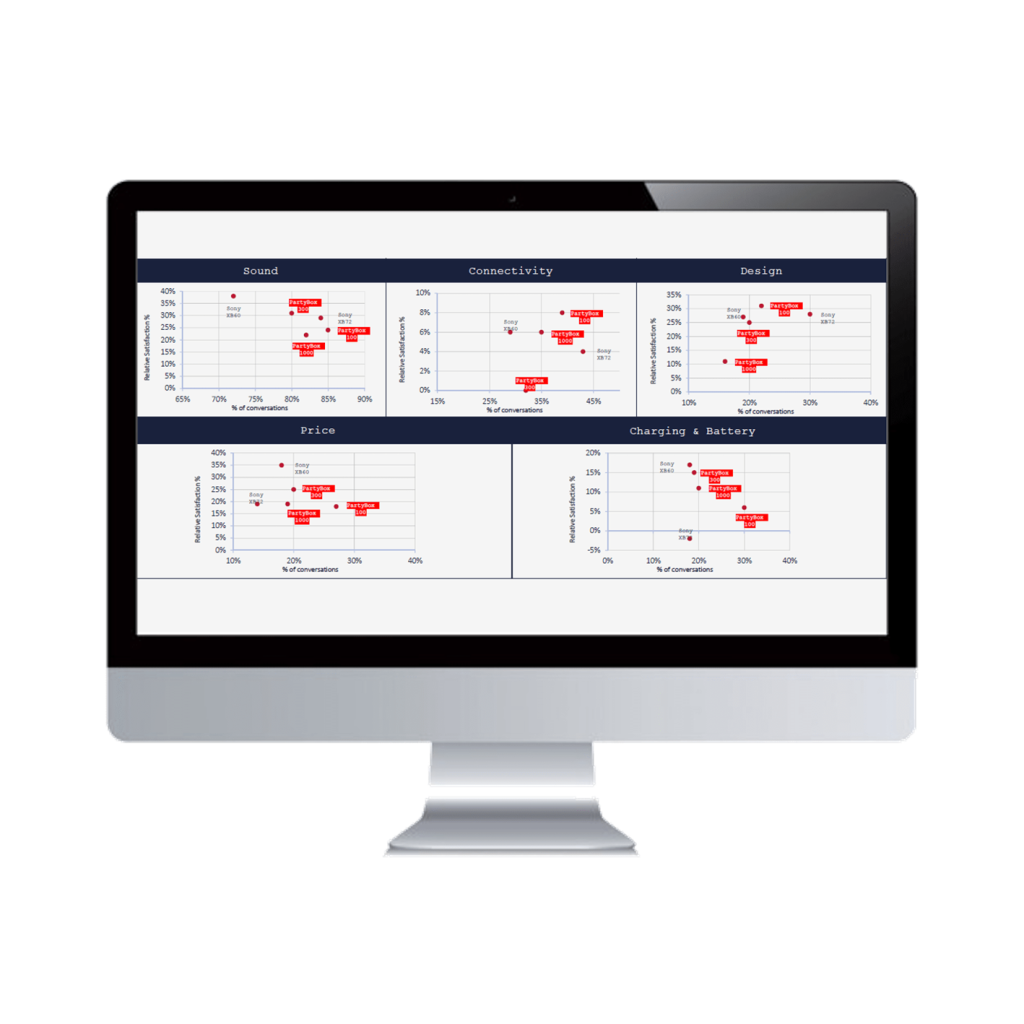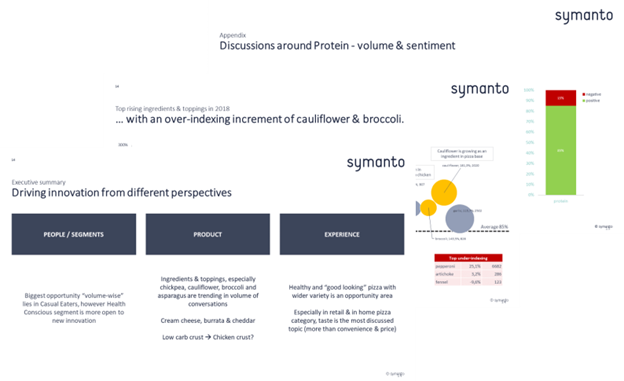The Voice of the Customer (VoC) has never been more powerful, and Voice of Customer examples are incontestable proof. We’re living in the age of social media, where consumers look to existing customers for feedback and reviews before purchasing.
At a time when customer service is more transparent and more public than ever, it’s imperative for businesses to gather and process all this information to get a deep understanding of the needs and values of their customers.
However, collecting and accurately analysing so much data across a plethora of channels is an insurmountable challenge for many analysts, draining them of time and resources.
Advanced AI technology is helping companies to consolidate information silos and quickly and accurately process thousands of comments and reviews within a matter of minutes, freeing up time for analysts to distil advanced Voice of Customer insights.
Find out what Voice of Customer is, examples of where to source customer feedback data, and cutting-edge ways of collecting, consolidating and analysing feedback for advanced and accurate insights.
What Is Voice of Customer?
Quite simply, the Voice of Customer, also called VoC, is the process of gathering customer feedback about their experiences, needs and preferences related to a brand and its products and services. And the buzz they create online around that business, like reviews and comments on social media and other streams where they share their experiences.
The aim is to understand what customers want and expect from you and how your offerings meet their desires and expectations. Plus, discover what makes them rave about your offering.
Nowadays, the voice of customer is a must-have for thriving businesses as it is one of the pillar elements in guiding decision-making in the right direction.
Whether it’s about fine-tuning your existing services, conceiving new products or polishing your marketing strategy, VoC is the compass that shows the direction your clients want your business to follow.
Voice of Customer can be conducted on your existing customer base or potential customers from, for example, competitor brands.
Why Is Voice of Customer Important for Businesses?
Actively listening to your customers is the Voice of the Customer in action. It’s the secret sauce that shapes your business strategies. You have to go beyond just hearing what your customers have to say; you have to understand what they want, adapt and act on these insights.
Let’s check some numbers to have a precise dimension of the customer feedback impact:
- 87% of clients hesitate to buy from businesses they don’t trust.
- 88% of buyers say the buying experience is as important as the products they purchase.
- 73% of customers expect companies to understand their particular desires and needs.
VoC boosts customer satisfaction and builds brand loyalty
When you pay attention and act on your customers’ requirements and preferences, you tell your clients that your business makes products and services better just for them.
A high level of attention wins their loyalty.
Voice of Customer highlights the areas of improvement
VoC is your business’s undercover detective on a mission to discover failures and below-standard experiences. And indicate areas where you need to make improvements and fix pain points.
VoC fuels innovation
VoC is the guiding light for product development. The customers’ opinions are a treasure trove of suggestions, improvement ideas, and desires your products should accomplish.
Turning these insights into action, your business comes up with innovative solutions that not only meet the clients’ needs but also have the potential to “wow” them with features they didn’t know they wanted.
The Voice of the Customer helps to build trust and credibility
Showing your customers that you genuinely care about them and their experiences is the foundation of lasting relationships based on trust.
Voice of the Customer Methodologies
Here are some examples of sources of customer feedback and methodologies to gather data that you can use to inform your VoC insights:
Surveys
Customer surveys enable you to ask your customers specific questions directly about their experience with your product, service, or brand.
Use open-ended questions to get more detailed insights and to allow your customers to express their experiences freely.
The resulting qualitative data is rich in valuable and actionable information but is also notoriously more challenging to analyse than closed-ended questions (for example, yes/no or multiple-choice questions). We’ll understand why that isn’t an issue with the right text analysis technology later.
Interviews and focus groups
Customer feedback interviews require more time and resources than surveys. However, the advantage of interviews is allowing your customers to direct the conversation and openly share their experiences without being led by a series of (potentially biased) questions.
A skilled interviewer can extract valuable customer responses and, if necessary, go off-script to gain original insights.
Review sites
Review sites are rich in beneficial qualitative data directly from customers. Unlike the two methods above, reviews are generated organically and are not subject to many biases in interviews and surveys.
According to a study led by PowerReviews, when shopping online, 99.9% of customers consult reviews first, and 96% look for negative reviews specifically.
Moreover, a BrightLocal survey reveals that 49% of customers put reviews at the same level of trust with recommendations from personal acquaintances.

Source: PowerReviews
Social media channels
Social media is another major source of organically generated data, rich in insights. It allows brands not only to observe but to participate in conversations with their customers. And is a perfect avenue to collect unfiltered feedback, identify trends, spot opportunities, and even address concerns openly.
Depending on the size of your business, social media can produce thousands of ready-to-analyse data points without having to spend time and resources sending out surveys or conducting interviews.
Customer service emails and chat logs
Customer service emails and chat logs are other examples of pre-existing customer feedback.
Your customer service agents are also helpful (albeit indirect) sources of information. Ask them about the most commonly occurring or most insightful customer conversations.
Customer-facing representatives have direct, day-to-day contact and experience with VoC.
Direct observations
So far, we’ve looked at methods of sourcing explicit customer feedback, but direct observation can sometimes enable you to intuit your customers’ needs implicitly.
For example, when Hewlett Packard wanted to develop technologies for operating theatre, they observed surgeons using their equipment.
They noticed that as surgeons were using a camera and screen to see what they were doing inside the body, there were several moments when their view was obstructed by assistants and nurses moving around the room.
This observation led Hewlett-Packard to develop a lightweight helmet that suspends a screen before the surgeon’s eyes.
Website behavior
Analysing customer behaviour on your website is another method to gain passive feedback for analysis.
With the help of built-in tools or external analysis tools, you can find out
- what pages your audience prefers most,
- which are the most popular products,
- how far from the homepage they navigate,
- what pages don’t get attention,
- what products are ignored?
Even this is majoritarian quantitative data when combined with qualitative elements to get a complete picture of user behaviour on your site.
Voice of Customer Examples from Prominent Brands
Let’s explore some voice of customer examples from big players and observe how they leveraged customer feedback to attain greater success.
Amazon
The e-commerce giant is one of the biggest winners and a true master of the voice of the customer game. They’ve led the understanding of customer preferences to the state-of-the-art level. And deliver a customer experience that feels tailor-made for each and every client.
Amazon’s recommendation system is the pure expression of the voice of the customer. They make the most of the customer data gathered, pay close attention and analyse what each user browses, what they buy, and what they look at.
Thus, they end up knowing their preferences like they would read the customers’ mind.
It’s the way that Amazon makes 35% of their yearly sales.
Moreover, they process and analyse this data via AI, and the output is AI magic at work. Such algorithms fit the pieces together and identify the users’ preferences, analyse their purchase history, and predict the items the user might be interested in next.
This way, the personalised recommendations backed by data-driven insights appeared.
What is the end result? A customer experience that feels tailor-made to the user and a top level of satisfaction.
The customer feels understood, cared for and delighted. It’s the main reason customers come back for more. Amazon knows it like no other and takes maximum profit from it.
Voice of the Customer Examples – Starbucks
Thanks to their appetite for listening carefully to what their clients crave, Starbucks is the master of brewing up customer-centric innovations.
And it is far more than a simple coffee shop. They’re collecting and brewing up a storm of ideas considering what customers suggest and want.
To gather their clients’ suggestions, they pay attention to the chatter – online submissions, in-store feedback, social media feedback or their dedicated platforms. Moreover, they are actively pursuing what makes their customers tick and act.
In 2022, the company put in place a “Reinvention plan” in collaboration with all partners to create a better Starbucks for the future and answer promptly to the increasing demands and changing preferences of the clients.
For instance, lately, the volume of cold beverages ordered surpassed that of hot drinks. Plus, two-thirds of drinks require personalisation, like adding flavours.
As a consequence, the company came up with a series of advancements related to coffee brewing technology, digital experiences and food productivity.
Such an example is Grande Mocha Frappuccino®, which has a new way of making it that takes 36 seconds and 13 steps. Meaning the beverage is delivered faster to the customer while maintaining its outstanding quality.
Another Starbucks characteristic generated by the Voice of Customer is its menu innovations. It’s the expression of a brand that turns customer suggestions into reality. From new snacks to seasonal drinks or tweaks to existing popular beverages, they constantly modify the menu to include clients’ requests.
But they are not just coming up with novelties; they stir up a buzz. They create a connection with a clientele that feels heard and valued and sees proof of it in every sip. That boosts engagement and is a straightforward recipe for increased visits and sales.
Voice of the Customer Examples for Business: Apple
Apple is another prominent example of excellence in customer-centric innovations and building a cult-like following. They don’t just create stellar, innovative products; they craft experiences by considering what their audience really wants.
Collecting feedback is an embedded, ongoing process. And it is gathered via a variety of touchpoints – support inquiries, direct customer interactions, reviews, online discussions, etc.
The brand puts the customer input at work and uses it as a blueprint for improvement. Look at their products! The subtle tweaks in their devices are not random upgrades; they are the result of customers’ preferences converted into reality.
From fine-tuning features to improving usability, Apple’s products follow the directives of the voice of their customers. When Apple implements improvements, they are not just making a better gadget. They nurture a fiercely loyal audience and create an ecosystem where their customers reign.
It’s a strategic move granting Apple dominance in a highly competitive market.
Another Voice of Customer example is the new Apple stores concept. At a Fortune summit, Apple’s senior vice president of retail, Angela Ahrendts, revealed that the organisation’s new stores aim to enrich customer lives and go beyond being simple retail stores.
“We are reinventing the role our stores and employees play in the community; we want to be more like a town square, where the best of Apple comes together and everyone is welcome.”
The central aspect of the new concept for Apple location will be related to community. It will include boardrooms for visiting entrepreneurs and coding classes for kids.
Consumer and B2B Electronics Provider Leverages VoC via Symanto
Listening carefully to the voice of customer enabled this large company that sells electronics to reduce the number of complaints and optimise the order process.
Even if the customer service staff knew about the typical customer issues, they couldn’t extract actionable insights because of the lack of in-depth analytics.
The company contracted Symanto’s expert team and used their next-gen platform to dig into the data and identify ways of improvement. Our team collected all the CRM complaints, call centre transcripts, reviews and complaints on social media and analysed them at a granular level.
Processing this customer feedback data, the CX team identified the battery feature as being a priority for improvement. And not the bass feature, as the product team thought.

Voice of Customer Examples for the Food Industry – McDonald’s
McDonald’s is more than the king of fast food; it serves its audience what it wants, where it wants it, and how it wants it. How do they manage it? By listening to the voices of their customers, they know their tastes and customise the menu with regional preferences.
Besides being a global company, they are local flavour connoisseurs. And dig deep into what locals love in terms of food. McDonald’s is an active and astute listener and makes maximum use of findings revealed by in-store feedback, online feedback, surveys or local market research.
A prominent example of the voice of customer implementation is the regional menu adaptations. From introducing unique dishes personalised to local tastes to tweaking ingredients, they serve precisely what clients want.
Such examples are
- McAloo Tikki Burger in India,
- spicy chicken McNuggets that include different spices depending on the region,
- fried chicken with McSpaghetti served in the Philippines,
- mini-calzone pastries filled with mozzarella and tomato sauce in Italy.
These local menu elements bring about 30% of McDonald’s food sales volume. Obviously, localising menus is a critical success driver for the company. And shows that it puts customers’ preferences front and center.
However, McDonald’s aims for more than just delivering what its clientele wants; it aims for leaving them “lovin’ it”. Indeed, when customers notice their favourite flavours present on the menu, that creates a connection and increases satisfaction.
Simply put, McDonald’s serves an experience that speaks customers’ local language.
Voice of Customer Example: Large Fast-Moving Consumer Goods Company
Check out how this company, active among others in the frozen pizza category, used the voice of its customers to discover hidden emerging consumer trends and surface some innovation opportunities.
Via the Symanto text analysis platform, more than 2 million consumer conversations related to pizza were gathered and analysed. Such discussions were found on recipe forums, reviews, social media networks, etc.
Symanto’s team of experts quickly identified new consumer segments looking for “healthy” and convenient pizza. And others who were interested in low-carb and high-protein pizza recipes.

Nestle
The consumer goods behemoth produces and sells more than goodies; they effectively cook up collaborations with their audience. Nestle found the recipe to create precisely the products their customers want by virtually inviting them into their creative kitchen.
But how do they do it? Primarily via extensive quantitative and qualitative market research via a multitude of initiatives and platforms that encourage consumers to share their thoughts, ideas and preferences. In a word, they are actively seeking customers’ input.
Nestle does not guess what their clients want; they ask, listen to, and act on customers’ feedback and requirements. They put a robust product strategy in place that concentrates on customers from every angle.
That’s why the company delivers snacks and drinks that appear to materialise from customers’ suggestions. Because it engages with its audience, analyses its preferences, and provides products that cater to its ever-changing tastes.
For instance, Nestle’s marketing team noticed a somewhat negative sentiment related to their infant nutrition products, particularly the formula. Digging into data and customer feedback revealed that the issues were caused by the packages that arrived damaged at the destination.
Moreover, Nestle is aware of the importance of including various perspectives when refining their products and creating new ones. It collaborates with a global network of culinary experts, nutritionists, and other scientists to ensure it continuously innovates and produces new variants of its products to satisfy a broad range of tastes.
Such an approach is a pure gold mine as it hits the sweet spot in the market. And delivers success stories for Nestle and its loyal customers.
The Challenge of Customer Experience Data
Quantity
When it comes to organically generated customer feedback (e.g. through social media, review sites, CRM data, chat logs, etc.), the greatest challenge for big brands is the sheer quantity of information created daily.
Analysts must find a way to quickly parse valid data (much of which is in unstructured text form) before it becomes irrelevant.
Quality
Surveys and interviews are often designed to make them easier to analyse. This means including closed-ended questions that are easy to quantify. However, this type of data is very limiting.
Furthermore, surveys and interviews are subject to other biases, such as leading, loaded or assumptive questions. In this sense, organically generated data is more likely to reflect consumer sentiment accurately.
Consolidation and correlation
As one can see, there are multiple sources of customer feedback. One of the challenges is finding a way to consolidate all the data from information silos and analyse and correlate it to obtain consistent insights.
Up to 80% of an analyst’s time (PDF) is spent gathering, cleaning and organising data, which could be better spent gaining insights and developing actionable steps for improvement.
Voice of Customer Tools: Get High Quality, Fast and Accurate Insights with Symanto
Symanto is a world leader in natural language processing (NLP) technology. We develop industry-leading models to derive deep insights from unstructured written data wherever it occurs.
Our technology can collect and analyse thousands of data points across dispersed channels within minutes. It can be as simple as entering the domain of a review site or social media channel you’d like to analyse.
With our advanced NLP capabilities, you can accurately detect topics and assign sentiment within written text, including comments, reviews, open-ended survey responses, chat logs, customer service emails, and more. Consolidate your information silos and get consistent Voice of Customer insights.
Find Out More About Symanto
To learn more about the potential of our technologies, get in touch or book a free personalised demonstration.
Nowadays, businesses have a vast array of innovative tools at their disposal designed to depict the customer’s voice. Some of these are:
- Survey platforms. They include templates and ready-made questionnaires that empower businesses to determine customers’ thoughts and preferences. And what really matters to them.
- Sentiment analysis tools. These apps gather and process loads of data from social media, reviews and other feedback to depict the emotions behind the customers’ words, their feelings and the overall context.
- Social media listening tools. Understand trends, conversations and opinions related to your brand by closely monitoring what’s happening on social media.
The real power of these tools relies on their potential impact on your business growth. When brands implement such tools effectively, they can profit from their data and convert them into actionable strategies that connect with their customers.
Voice of Customer Questions. How to Craft Effective Feedback Strategies?
What makes a voice of customer questions effective? It’s not just about words; it’s about the ability to get the answers you need. And also generate valuable insights. Such questions are personalised based on industry and scenario.
For instance, a hospitality business might use questions related to guest experiences, asking about the stay, the elements that made it memorable, what could be improved, etc.
A tech brand might be more interested in asking questions about the usability of an app, about the customer journey through it, where customers stumbled, or what enchanted them.
Well-structured questions have the capacity to convert customer feedback into actionable changes. Their purpose is to reveal the secrets that your clients are eager to share.
Voice of Customer Mistakes
The primary purpose of customer feedback is to interpret the data correctly and extract valuable insights to polish business strategies. But sometimes missteps appear, like:
Cherry picking feedback
Concentrating just on positive or negative feedback can be a mistake because you cannot ignore the bigger picture. You may be missing vital insights if you review just some selected aspects.
Skipping on details
Sometimes, you have to go behind simple words to get the whole meaning. It may arrive that what is said isn’t exactly what was meant; thus, understanding the entire context behind the feedback is vital.
Misinterpreting feedback
Understanding feedback in a different key may lead to unwanted results. For example, a business receives multiple complaints about the complexity of its product. Instead of finding ways to simplify the product, they add more features, making the product even more complicated. The result is a frustrated audience.
The best way to counterbalance such mistakes is to take a holistic approach to feedback and take into consideration the context.
Take Away
Today, leveraging the VoC should be a priority of any business.
Learn from the above-mentioned voice of customers’ examples, tools, questions and mistakes and create an accurate, impactful and insightful VoC strategy.

